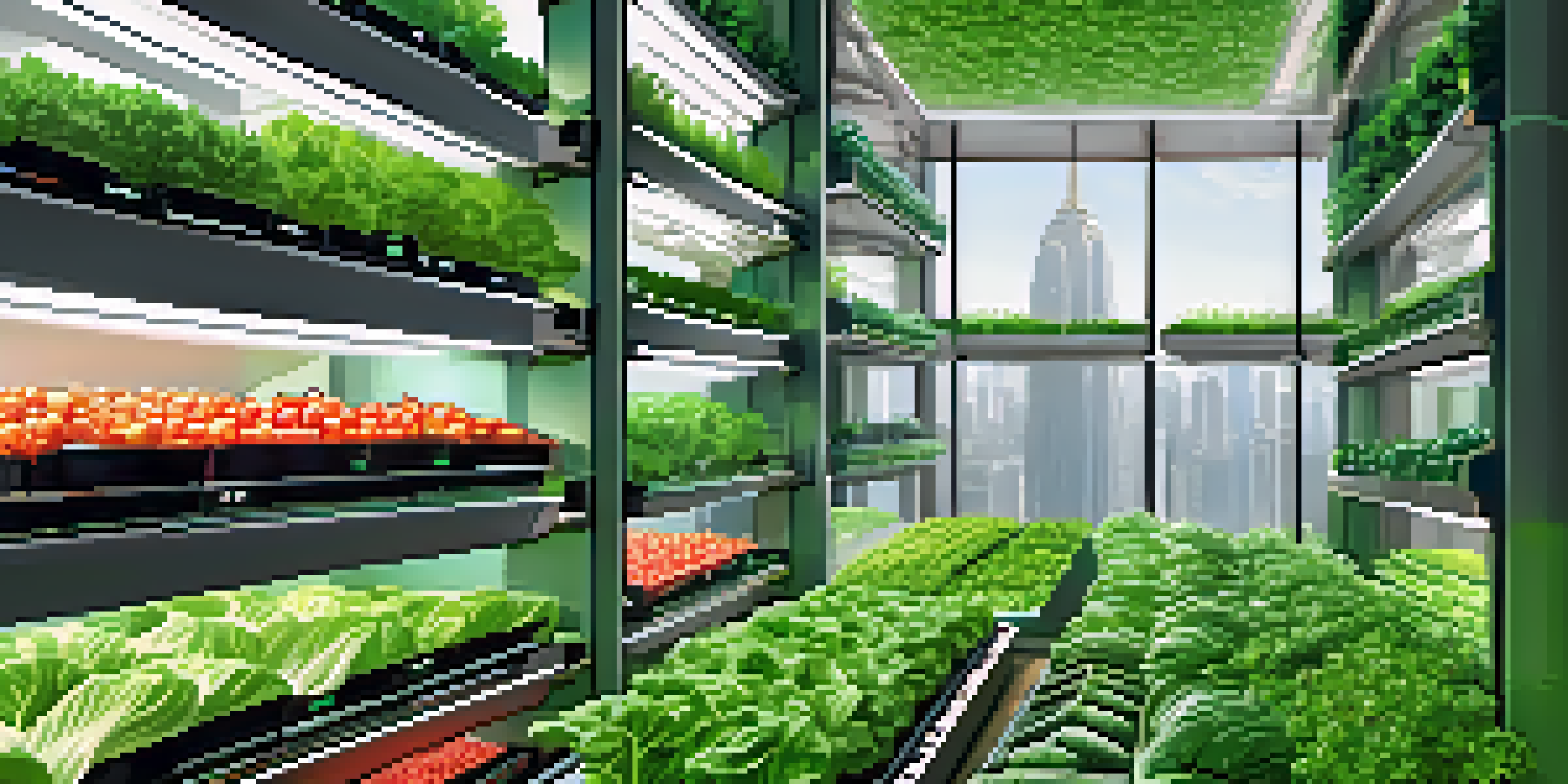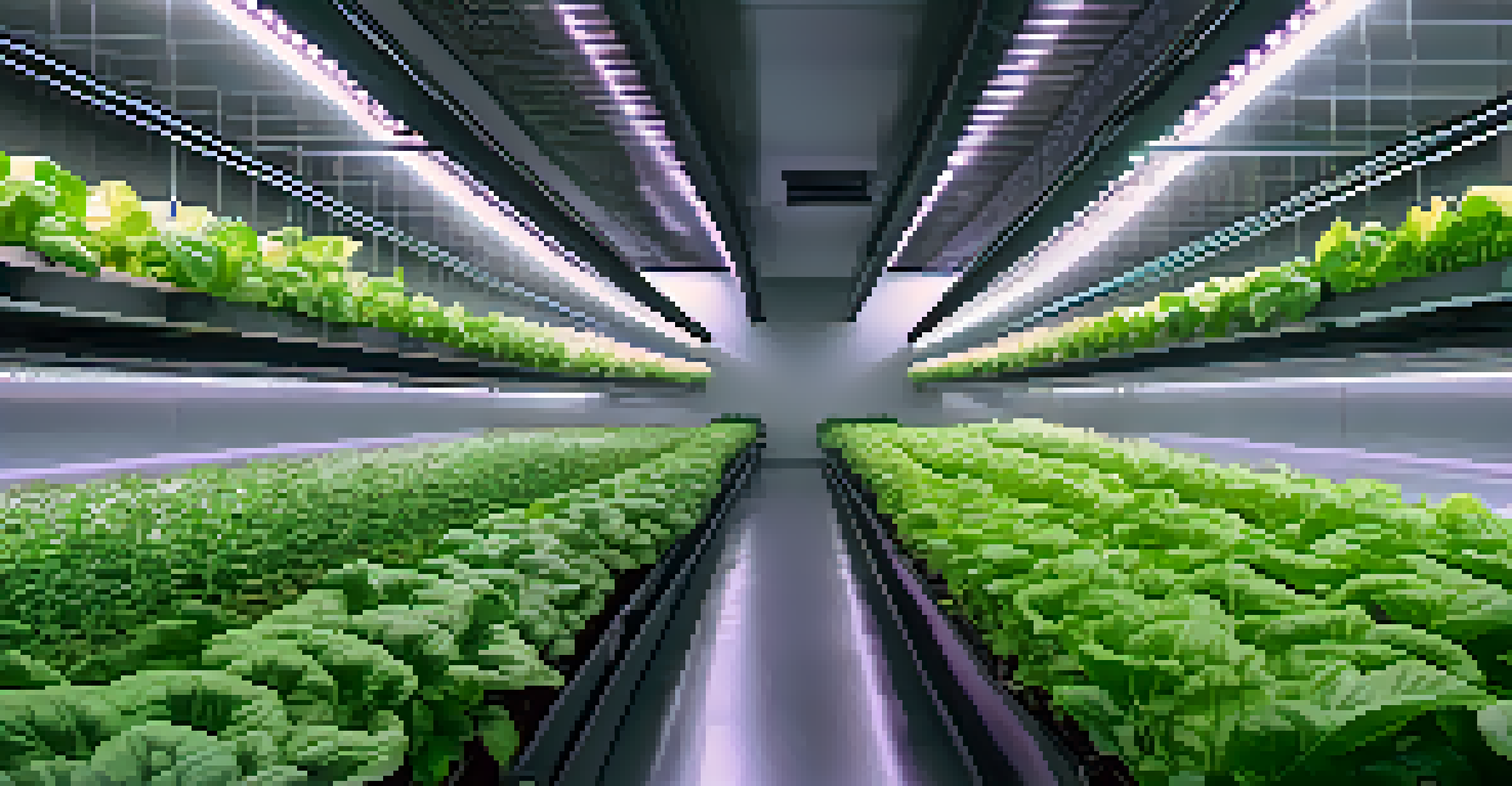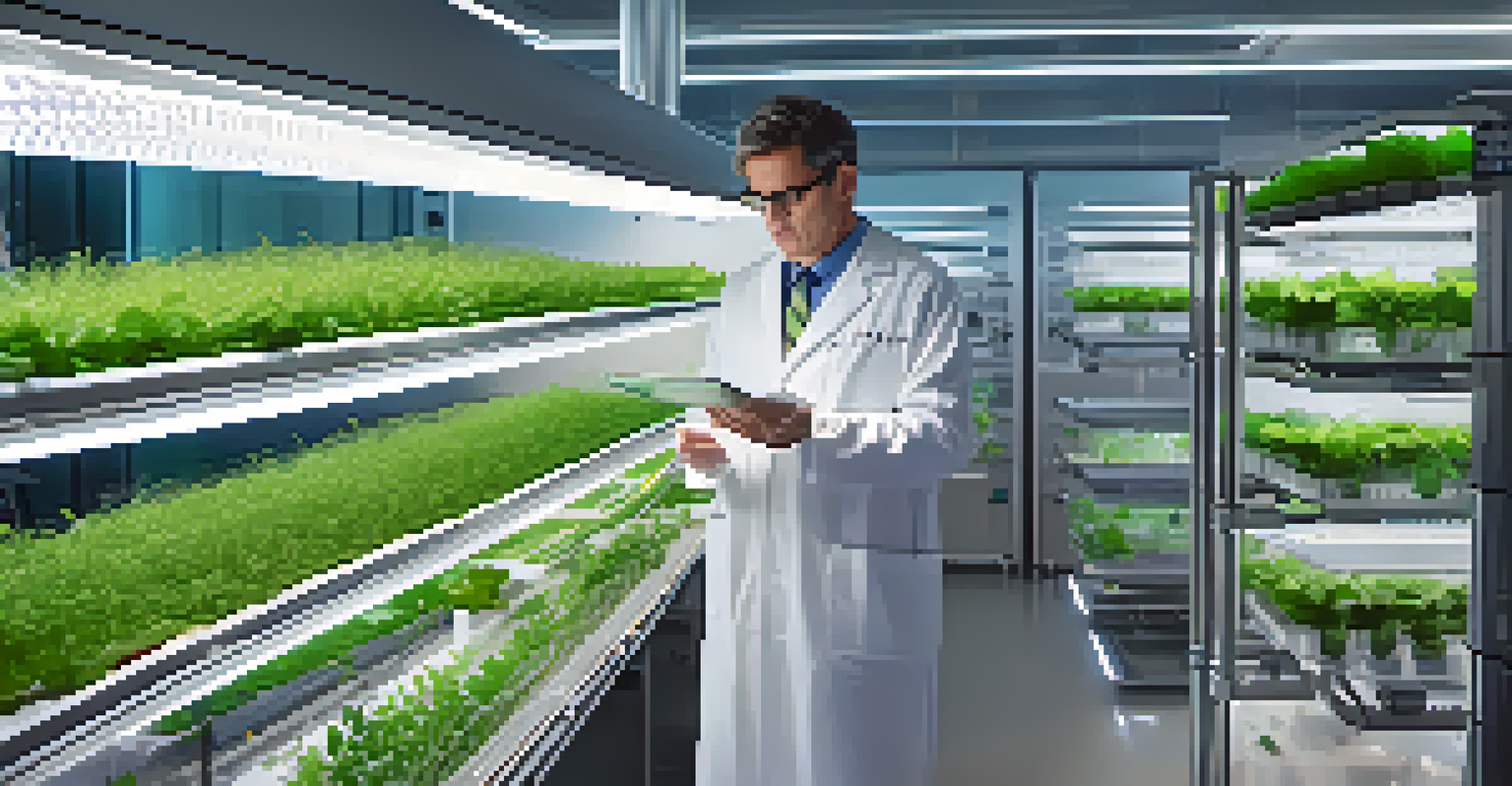The Future of Vertical Farming and Plant Science Integration

Understanding Vertical Farming: A Modern Solution
Vertical farming represents a groundbreaking shift in agriculture, where crops are grown in stacked layers, often inside controlled environments. This method optimizes space and resource use, making it particularly valuable in urban settings where land is scarce. Imagine a skyscraper dedicated to growing fresh produce right in the heart of a bustling city, reducing the need for transportation and lowering carbon footprints.
The future of food is not just about feeding people, but nourishing the planet.
As cities continue to grow, the demand for fresh food increases. Vertical farms can produce vegetables and herbs year-round, regardless of the climate outside. They take advantage of advanced technologies, such as hydroponics and aeroponics, which allow plants to thrive without soil, using nutrient-rich water instead.
Moreover, vertical farming can significantly reduce the use of pesticides and fertilizers, contributing to healthier crops. By integrating plant science, growers can develop tailored environments that maximize yield and minimize waste, creating a more sustainable food system for future generations.
Plant Science: The Backbone of Successful Vertical Farms
At the core of successful vertical farming lies plant science, the study of how plants grow, reproduce, and interact with their environment. Understanding these principles allows farmers to optimize conditions for growth, such as light, temperature, and humidity. For instance, researchers can determine the ideal light spectrum for various crops, enhancing photosynthesis and accelerating growth rates.

By applying genetic research, scientists are also developing plant varieties that are better suited for vertical farming. These innovations can lead to crops that grow faster, have higher nutritional value, and are more resistant to diseases. This is akin to tailoring a sports team to ensure each player excels at their role, ultimately leading to a winning season.
Vertical Farming Optimizes Resources
By utilizing stacked layers and controlled environments, vertical farming significantly increases food production in urban areas while minimizing land use.
The collaboration between plant scientists and vertical farmers is crucial in addressing challenges like pest management and climate variability. By leveraging scientific insights, farmers can create resilient systems that adapt to changing environmental conditions, ensuring a stable food supply even in unpredictable climates.
Technological Innovations Driving Vertical Farming
Vertical farming is not just about stacking crops; it's also a hub of technological innovation. From automated systems that monitor plant health to AI-driven data analytics predicting optimal harvest times, technology plays a vital role in this agricultural revolution. Imagine robots that can tend to plants, detect diseases early, and even harvest crops—all while significantly reducing labor costs.
Sustainability is not a destination, but a journey we must take together.
Additionally, the integration of IoT (Internet of Things) devices allows farmers to monitor conditions in real time. Sensors can track moisture levels, nutrient concentrations, and light intensity, providing instant feedback on the plants’ needs. This real-time data helps farmers make informed decisions that improve yield and resource efficiency.
As technology continues to advance, the potential for vertical farming expands. Innovations like vertical aeroponic systems, which mist roots with nutrient solutions, promise to further enhance efficiency and sustainability, making it possible to grow more food with less water and fewer resources.
The Role of Sustainability in Vertical Farming
Sustainability is at the heart of vertical farming, as it aims to reduce the environmental impact of traditional agriculture. By cultivating crops indoors, vertical farms can significantly lower water usage—often up to 90% less than conventional farming methods. This is crucial in regions facing water scarcity, where every drop counts.
Moreover, vertical farming reduces the need for long-distance transportation, thereby cutting down on carbon emissions. When fresh produce is grown close to urban centers, it reaches consumers faster, maintaining its nutritional value and flavor. It's like having a farmer's market right at your doorstep, where freshness is guaranteed.
Sustainability is Key to Success
Vertical farming dramatically reduces water usage and carbon emissions, making it a more sustainable alternative to traditional agriculture.
The use of renewable energy sources, such as solar panels and wind turbines, further enhances the sustainability of vertical farms. By harnessing natural energy, these farms can operate with a minimal carbon footprint, paving the way for a greener future in agriculture.
Economic Implications of Vertical Farming
The rise of vertical farming brings significant economic opportunities. As urban populations grow, the demand for locally sourced, fresh food increases, positioning vertical farms as a viable business model. Entrepreneurs are recognizing the potential for profitability in this sector, leading to a surge in investment and innovation.
Additionally, vertical farming creates jobs in various fields, from engineering to horticulture. This diversification of roles is akin to the tech boom, where a single industry spawned numerous job opportunities across different sectors. As vertical farming continues to expand, it could become a cornerstone of urban economies.
However, challenges remain, such as high initial setup costs and the need for skilled labor. Addressing these hurdles through policy support and education can ensure that vertical farming becomes a sustainable economic solution, benefiting both communities and the environment.
Challenges and Limitations of Vertical Farming
Despite its promise, vertical farming faces several challenges that need addressing. One of the most significant hurdles is the high energy consumption associated with artificial lighting and climate control. While innovations are helping reduce these costs, energy efficiency remains a critical concern for the long-term viability of these systems.
Moreover, the initial investment for establishing a vertical farm can be substantial. This can be a barrier for small-scale farmers looking to enter the market. It's similar to starting a tech startup; the potential is immense, but the upfront costs can deter many from taking the plunge.
Economic Growth through Innovation
As demand for fresh food rises, vertical farming presents new economic opportunities by creating jobs and attracting investment in urban centers.
Lastly, while vertical farms can produce a variety of crops, they may not yet replace traditional farming for all types of produce. Certain crops, like grains, are still more efficiently grown in open fields. Finding the right balance between vertical and conventional farming will be essential in creating a diversified and resilient food system.
The Future of Food: Integrating Vertical Farming and Plant Science
Looking ahead, the integration of vertical farming and plant science is poised to reshape our food systems. As research continues to unlock the potential of plant genetics and cultivation techniques, we can expect to see even more efficient and sustainable practices emerge. Picture a future where food is grown in urban centers, reducing food deserts and ensuring access to fresh produce for all.
This synergy could lead to innovations we can't yet imagine, fostering collaboration between scientists, farmers, and technologists. By combining their expertise, they can develop solutions that address global challenges like hunger and climate change. It's a bit like a team of chefs coming together to create a signature dish—each contributes unique flavors to achieve a remarkable outcome.

Ultimately, the future of vertical farming and plant science integration holds the promise of a more sustainable and equitable food system. As we embrace this new era of agriculture, we can cultivate not just crops but also a healthier planet for generations to come.